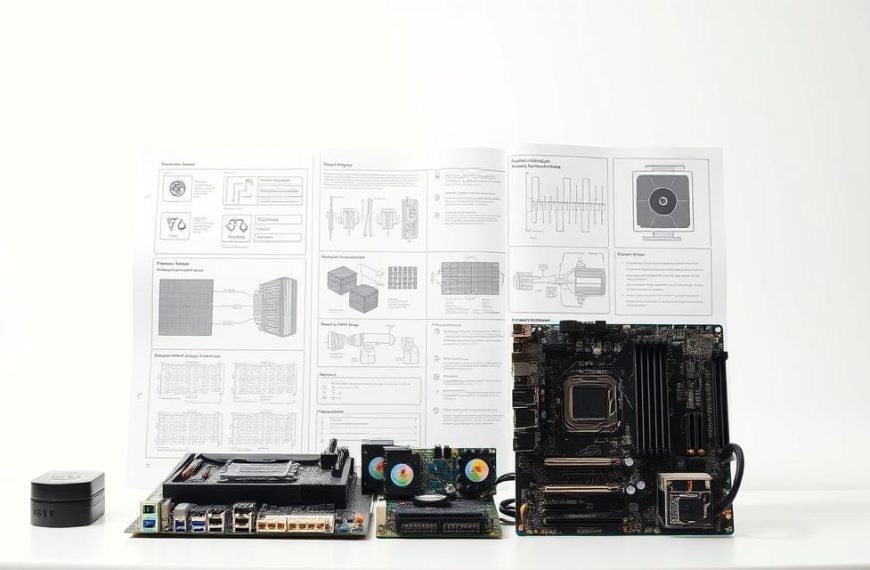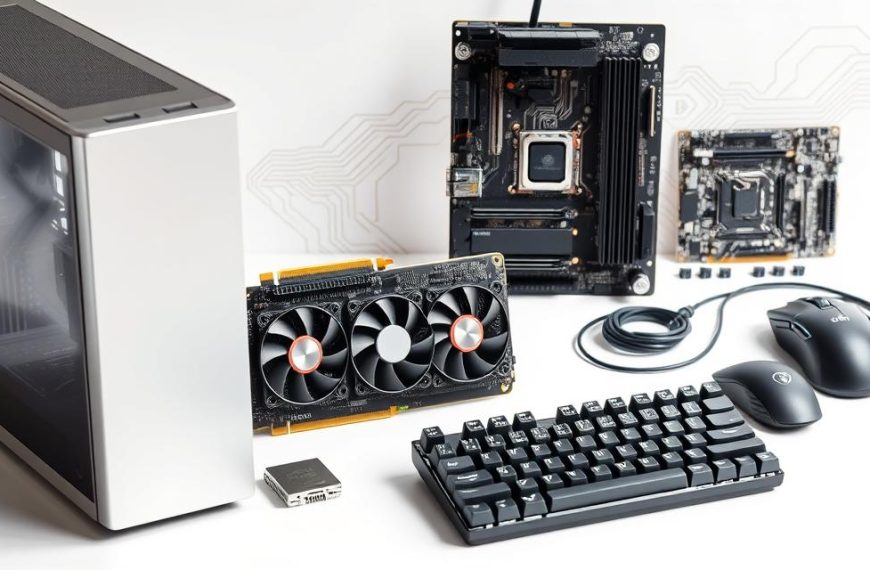Artificial intelligence is reshaping industries at an unprecedented pace. Over 77% of companies now explore or deploy AI solutions, driven by its potential to boost efficiency and revenue. The global market for this technology is projected to grow by 38.1% annually, reaching new heights by 2030.
From predictive maintenance in manufacturing to personalized learning in education, AI delivers measurable results. McKinsey estimates a staggering $4.4 trillion in productivity gains across corporate use cases. Brands like Coca-Cola already harness its creative power, as seen in their AI-generated “Masterpiece” campaign.
Nearly 83% of organizations prioritize AI in strategic planning. The growth stems from tangible outcomes—63% of early adopters reported revenue increases, while costs dropped by 37%. As adoption spreads, industries witness efficiency improvements ranging from 50% to 150%.
This technology isn’t just automating tasks. It’s redefining customer interactions, with 85% of relationships expected to be AI-managed soon. The impact extends globally, potentially adding $15.7 trillion to the world economy.
The Transformative Power of AI in Modern Business
Retail giants demonstrate the tangible benefits of cognitive automation. Walmart’s inventory systems now predict demand with 98% accuracy, reducing overstock by 35%. This neural network analyzes weather patterns, local events, and purchase histories in real-time.
Meanwhile, Marks & Spencer revolutionized digital fashion through machine vision. Their style advisor tool increased online conversions by 28%. The algorithm suggests outfits based on body type, preferred colors, and trending items.
Traditional automation follows rigid rules, while machine learning adapts dynamically. Robotic arms in factories perform repetitive tasks, but cognitive tools like Salesforce’s Agentforce redesign entire workflows. This platform autonomously routes service tickets based on urgency and agent expertise.
| Feature | Traditional Automation | Cognitive Automation |
|---|---|---|
| Learning Ability | Fixed programming | Continuous improvement |
| Decision Making | Rule-based | Context-aware |
| Error Handling | Manual intervention | Self-correction |
PwC research reveals cognitive tools bridge critical gaps in customer understanding. Satisfaction prediction accuracy jumped from 38% to 63% among early adopters. These processes analyze sentiment across emails, calls, and reviews simultaneously.
Forward-thinking business leaders recognize this shift. Over 56% of organizations now deploy intelligent tools for operational gains. The productivity boost exceeds 1.5% annually according to McKinsey benchmarks.
How AI Will Impact Business in the Next Decade: Key Trends
Industries worldwide are experiencing rapid transformation through advanced technologies. These innovations drive measurable improvements in productivity, accuracy, and cost reduction. Two dominant forces emerge as primary catalysts for change.
Industry-Wide Automation Surge
Manufacturing leads the charge with record robotic installations. The International Federation of Robotics reports 2023 as a historic year for industrial automation. Predictive maintenance systems now prevent equipment failures before they occur.
Construction firms achieve 50% productivity gains through real-time analytics. McKinsey data shows drones and sensors providing instant site updates. This eliminates costly delays and material waste.
Retailers like Amazon demonstrate automation’s profit potential. Their recommendation algorithms boost earnings by 25-95%. These systems analyze billions of data points to personalize shopping experiences.
Decision Intelligence Revolution
Netflix showcases the power of intelligent data analysis. Their content suggestion engine prevents over $1 billion in annual losses. The platform processes viewing patterns across 220 million subscribers.
Mining operations process geological data 18 times faster through cognitive tools. Deloitte research highlights how these insights optimize exploration and extraction. Workers spend less time analyzing and more time executing.
Thomson Reuters predicts professionals will save 12 weekly hours by 2029. Automated research tools deliver accurate legal and financial insights instantly. This shift allows deeper analysis of complex cases.
For more on these transformative developments, explore AI’s growing influence across sectors. The financial sector particularly benefits from enhanced fraud detection capabilities.
Energy companies achieve remarkable efficiency through smart grid management. These processes balance supply and demand while reducing waste. The results demonstrate technology’s role in sustainable operations.
AI’s Current Role in Business Operations
Modern enterprises increasingly rely on intelligent solutions to streamline daily operations. These technologies deliver measurable improvements across service and logistics functions. Over 92% of support teams report faster response times when using automated systems.
Revolutionizing Customer Service with Chatbots
Virtual assistants now handle complex customer interactions with human-like precision. Bank of America’s Erica chatbot processes over 50 million client requests annually. Key advantages include:
- 24/7 availability across time zones
- Instant access to account histories
- Multilingual support capabilities
Financial institutions like Certif-ID deploy advanced fraud detection tools. Their algorithms analyze transaction patterns to flag suspicious activity. This reduces false positives by 40% compared to traditional methods.
Optimizing Supply Chain and Inventory Management
Logistics networks achieve unprecedented efficiency through predictive analytics. DHL’s route optimization systems cut fuel consumption by 15% annually. The technology considers:
- Real-time traffic data
- Weather conditions
- Delivery time windows
Starbucks’ Deep Brew platform demonstrates AI’s potential in inventory management. The solution forecasts ingredient needs across 30,000 locations with 95% accuracy. Similar processes help UPS save 10 million gallons of fuel yearly through smarter route planning.
These implementations showcase technology’s transformative effect on core customer and operational functions. As adoption grows, businesses gain competitive advantages through smarter tools and workflows.
Industry-Specific AI Applications
From hospitals to financial institutions, intelligent solutions deliver measurable improvements. Nearly 38% of healthcare providers now utilize diagnostic tools, while banking products approach $1 billion in projected value. These industries demonstrate technology’s transformative potential.
Healthcare: AI in Diagnostics and Patient Care
PathAI achieves 99% accuracy in cancer detection, outperforming human pathologists. Their solutions analyze tissue samples with microscopic precision, reducing diagnostic errors by 85%.
“What previously took days now happens in minutes, giving patients faster treatment pathways.”
NVIDIA’s Clara imaging platform cuts MRI scan times by 50%. Olive AI automates $5 billion in annual administrative transactions, streamlining:
- Insurance claim processing
- Patient record management
- Appointment scheduling
| Diagnostic Method | Accuracy Rate | Processing Time |
|---|---|---|
| Traditional Pathology | 94% | 72 hours |
| AI-Assisted Analysis | 99% | 45 minutes |
Finance: Fraud Detection and Personalized Banking
JPMorgan Chase’s COiN platform reviews 12,000 contracts in seconds. The system identifies anomalies with 98.5% precision, saving 360,000 labor hours annually.
Personalized banking products analyze customer behavior to recommend tailored services. Real-time fraud detection systems prevent $7 billion in annual losses across major banks.
Retail: Hyper-Personalization and Demand Forecasting
Lowe’s analytics solutions reduce out-of-stock scenarios by 30%. The platform processes:
- Local buying trends
- Weather patterns
- Seasonal demand shifts
Amazon’s recommendation engine drives 35% of total sales through customer-specific suggestions. These data-driven approaches reshape shopping experiences across industries.
The Rise of AI-Powered Analytics
Advanced analytics now drive strategic decisions with unprecedented precision. Over 80% of executives report improved choices as the top benefit of these tools. The accounting market alone expects $161.8 million in AI analytics value by 2028.
Salesforce Einstein demonstrates this shift effectively. Its predictive lead scoring boosts conversions by 35%. The system evaluates:
- Historical purchase patterns
- Engagement metrics
- Demographic correlations
Bloomberg’s terminal processes over 10 million news sources simultaneously. This real-time data processing helps traders spot opportunities 47% faster. Financial institutions rely on these insights for billion-dollar decisions.
Unilever accelerated product development by six months using trendspotting algorithms. Their analysis identifies emerging preferences across social platforms. This approach reduced failed launches by 28%.
| Metric | Traditional Analytics | AI-Powered Analytics |
|---|---|---|
| Processing Speed | Hours/Days | Seconds/Minutes |
| Data Sources | Structured databases | Multimedia streams |
| Prediction Accuracy | 72-85% | 89-97% |
Domino’s Pizza Hero tailors menus using location-specific data. The system considers neighborhood demographics and ordering histories. This boosted same-store sales by 18% in test markets.
John Deere’s See & Spray technology exemplifies environmental benefits. Image analysis reduces herbicide use by 80%. Cameras identify weeds with 95% accuracy, targeting only affected areas.
These innovations prove that intelligent insights create tangible value across sectors. From finance to agriculture, decision intelligence becomes the new competitive standard.
AI and the Future of Work: Job Disruption vs. Creation
Workplace dynamics are undergoing radical shifts due to intelligent automation. HubSpot research reveals 66% of companies now hire for specialized AI roles, while 16% of existing positions face potential replacement by 2025. This transformation creates both challenges and opportunities for employees across sectors.
Roles Most Likely to Be Transformed
Legal professionals face disruption as GPT-4 outperforms 90% of human bar exam takers. In education, Duolingo’s AI instructors now handle 40% of language lessons. These changes primarily affect tasks involving:
- Standardized knowledge application
- Repetitive information processing
- Basic customer interactions
PwC’s $1 billion upskilling program prepares 65,000 employees for this shift. Their initiative focuses on developing human strengths like creative problem-solving and emotional intelligence.
Emerging AI-Centric Job Categories
Upwork reports a 300% surge in prompt engineering gigs since 2023. New roles demand hybrid skills combining technical literacy with domain expertise. MIT research shows teams augmented by intelligent tools achieve 35% higher productivity.
“The most valuable professionals are those who can direct AI effectively, not those who compete with it.”
This development creates demand for positions like AI trainers and data ethicists. Successful organizations will balance automation with strategic human capital work.
Economic Implications of Widespread AI Adoption
Economic power balances face disruption as nations adopt cognitive technologies at varying speeds. PwC projects $15.7 trillion in global GDP growth by 2030, with 42% of companies already reporting significant cost reductions. This transformation creates both opportunities and challenges across economic ecosystems.
Developed nations currently lead in implementation, creating a widening gap:
- North America accounts for 52% of private AI investment
- Emerging markets face 18-month adoption lags
- Workforce upskilling programs show 3x higher funding in G7 nations
Tech monopolization risks emerge as five companies control 78% of advanced AI patents. This concentration could stifle competition, particularly in:
- Cloud infrastructure (72% market share held by three providers)
- Training data access
- Specialized talent pools
Manufacturing sees dramatic reshoring potential through smart automation. Taiwan Semiconductor achieved $40 billion in efficiency gains through:
- AI-driven defect detection (99.9% accuracy)
- Predictive maintenance (85% fewer outages)
- Yield optimization (12% increase)
“Automation disproportionately benefits capital over labor, potentially widening income inequality by 14% in vulnerable sectors.”
| Economic Factor | AI Impact | Timeframe |
|---|---|---|
| Productivity | +1.5% annual growth | 2025-2030 |
| Labor costs | 23-35% reduction | Manufacturing sectors |
| R&D Efficiency | 40% faster development | Pharma/tech |
The energy sector demonstrates environmental economic benefits. Smart grid management reduces operational costs by 17% while cutting emissions. These dual advantages make sustainable growth increasingly achievable.
Emerging markets could leapfrog traditional infrastructure with mobile-first AI solutions. Successful implementations in Kenya and Indonesia show 28% higher financial inclusion rates through cognitive banking tools.
AI-Driven Productivity Gains: What the Data Shows
Cognitive tools are rewriting productivity benchmarks across industries. Employees now save over two daily hours through automation, while construction firms achieve 50% output increases. These advancements redefine what’s possible in modern workplaces.
Accenture’s contract analysis solutions demonstrate dramatic improvements. Legal teams review agreements 70% faster using natural language processing. This time reduction allows deeper focus on strategic negotiations.
Siemens transformed manufacturing processes with visual inspection systems. Defect detection algorithms cut equipment downtime by 45%. The technology analyzes 5,000 components hourly with 99.8% accuracy.
| Company | Application | Efficiency Gain | Time Saved |
|---|---|---|---|
| Marriott | AI Concierge | 5M+ annual requests | 2.4M staff hours |
| Deloitte | Audit Analysis | 10M docs in 10 mins | 92% faster |
| Construction | Site Analytics | 50% productivity | 30% shorter timelines |
Hospitality leaders like Marriott handle millions of guest interactions seamlessly. Their virtual assistant manages room service orders and local recommendations. This automation frees staff for complex customer needs.
Deloitte’s audit platform processes regulatory documents at unprecedented speeds. What required weeks now completes during coffee breaks. Professionals shift from manual reviews to strategic oversight.
“Knowledge workers will see 40% productivity jumps by 2026 as routine tasks become automated.”
These case studies prove intelligent solutions deliver measurable operational advantages. Early adopters gain competitive edges through optimized workflows and resource allocation.
The Role of Leadership in AI Integration
Corporate success with emerging technologies now depends heavily on visionary leadership. McKinsey data reveals a 5% gap between leaders (99% AI familiarity) and employees (94%), highlighting crucial alignment needs. Microsoft research shows 66% of executives prioritize AI skills in hiring decisions.
Freshworks indicates only 23% of teams see business leaders driving integration. This disconnect creates challenges in scaling intelligent solutions effectively. Korn Ferry confirms 82% of CEOs recognize the technology’s transformative potential, yet implementation often lags.
Building an AI-Ready Workforce
Walmart’s $2 billion AR/VR training program sets the industry standard. Over 1.5 million associates now use immersive simulations for:
- Inventory management scenarios
- Customer service role-playing
- Equipment troubleshooting drills
Microsoft’s AI Skills Challenge certified 1 million professionals last year. Their learning paths combine technical modules with ethical considerations. Unilever pairs 15,000 staff with machine learning mentors through structured rotations.
Overcoming Resistance to Change
Boeing reduced implementation friction by 60% through transparent communication. Their change management program emphasizes:
- Monthly technology demos
- Cross-functional pilot teams
- Clear performance metrics
“Building trust requires showing how tools augment human capabilities rather than replace them.”
GE’s Predix platform upskilled 30,000 technicians through hands-on simulations. Field maintenance accuracy improved by 38%, proving effective training drives adoption. These initiatives demonstrate that empowered employees accelerate technology integration.
Ethical Considerations in Business AI Applications
Ethical challenges emerge as cognitive technologies integrate deeper into corporate operations. Over 38% of intelligent systems show measurable bias, while 85% of consumers demand transparency. Companies must balance innovation with accountability to maintain trust.
Addressing Algorithmic Bias
IBM’s AI Fairness 360 toolkit detects 20+ bias metrics, from gender disparities to racial inequities. Real-world issues include:
- Mortgage algorithms denying loans to people of color at higher rates
- Facial recognition systems misidentifying darker-skinned individuals
- HR tools favoring male candidates for technical roles
Adobe’s Content Authenticity Initiative combats deepfakes by watermarking synthetic media. Their model embeds origin data, helping users distinguish real from AI-generated content.
Ensuring Data Privacy and Security
Mastercard’s DECAIN platform uses federated learning to analyze financial data without central storage. This approach:
- Keeps sensitive information on local devices
- Shares only anonymized insights
- Reduces breach risks by 73%
“Unregulated AI could replicate human prejudices at scale, requiring proactive governance.”
The EU AI Act mandates strict rules for high-risk applications. Compliance teams now audit:
- Biometric identification tools
- Automated hiring systems
- Predictive policing algorithms
DeepMind’s ethics board oversees medical AI deployments, ensuring patient trust through transparent decision logs. Their review process catches 92% of potential biases before clinical use.
AI’s Environmental Impact: A Double-Edged Sword
Energy consumption and conservation efforts collide in AI’s environmental paradox. Training advanced models emits CO2 equivalent to five car lifetimes, yet smart grids using these systems could achieve 93% of climate targets.
Google reduced data center cooling costs by 40% through DeepMind optimization. Their algorithm predicts server temperatures six hours ahead, adjusting cooling processes dynamically. This innovation saves enough energy to power small towns annually.
Microsoft’s AI for Earth program tracks 100 million conservation data points. The solutions monitor deforestation patterns and endangered species movements. Conservationists receive real-time alerts about illegal logging activities across protected areas.
“We must weigh AI’s carbon footprint against its power to solve environmental crises.”
Bitcoin mining consumes more electricity than entire countries, while AI optimization saves comparable amounts. Ørsted’s wind farms increased output 15% through predictive maintenance algorithms. Turbines now self-adjust to weather changes before they occur.
| Technology | Energy Use | Environmental Benefit |
|---|---|---|
| AI Training | 300,000 kg CO2 | N/A |
| Smart Grids | High initial | 30% reduction long-term |
| Dojo Supercomputer | 80% less | Faster EV development |
Tesla’s Dojo supercomputer slashes training emissions by 80% through efficient chip architecture. This impact proves sustainable innovation can coexist with technological advancement when properly engineered.
Preparing Your Business for AI Disruption
McKinsey research reveals stark disparities in corporate readiness for cognitive automation. While 92% of companies plan increased investments, merely 1% achieve full maturity. This gap highlights critical preparation needs across leadership, infrastructure, and workforce capabilities.
Assessing Organizational Readiness
PwC’s AI Maturity Index evaluates four core dimensions:
- Data readiness: Quality and accessibility of information assets
- Process adaptability: Capacity for workflow redesign
- Talent pipelines: Internal skills development programs
- Governance structures: Ethical and risk management frameworks
“Mature adopters demonstrate 3x faster implementation cycles and 47% higher ROI from intelligent tools.”
| Maturity Level | Data Utilization | Use Case Complexity | Employee Upskilling |
|---|---|---|---|
| Beginner | Basic reporting | Rule-based automation | Ad hoc training |
| Intermediate | Predictive analytics | Departmental solutions | Structured programs |
| Advanced | Real-time decisioning | Enterprise transformation | Continuous learning |
Identifying High-Impact AI Use Cases
Home Depot’s inventory optimization solutions demonstrate focused application. Their algorithm analyzes 35,000 SKUs, eliminating 15% slow-moving products. This freed $7 billion in working capital annually.
Nestlé’s opportunity mapping identified $300 million savings through:
- Automated quality control in 76 factories
- Dynamic routing for 12,000 delivery vehicles
- Personalized recipe development at scale
Verizon showcases defensive applications, stopping 1.5 billion monthly cyberattacks. Their threat detection tools analyze network patterns 400x faster than human teams.
Gartner’s adoption roadmap provides actionable steps:
- Conduct capability audits across business units
- Prioritize quick-win pilot projects
- Establish cross-functional governance teams
- Scale successful implementations enterprise-wide
- Measure and optimize performance metrics
Proactive preparation turns disruption into strategic advantage. Business leaders who align technology with operational needs will dominate their sectors.
The Competitive Advantage of Early AI Adoption
Pioneering firms gain measurable advantages by embracing cognitive technologies ahead of competitors. MIT research confirms early adopters achieve 20% higher profitability than peers. This growth gap widens as solutions mature.
Amazon demonstrates this edge through machine learning-powered logistics. Their 24-hour delivery promise relies on:
- Real-time traffic pattern analysis
- Dynamic warehouse inventory placement
- Autonomous routing algorithms
L’Oréal captured 30% new market share with skin diagnostic products. The tool analyzes 13,000 facial attributes to recommend personalized regimens. Forrester reports similar companies see 6% revenue boosts from such implementations.
“First movers build capabilities that later entrants struggle to replicate, creating lasting competitive moats.”
John Deere’s automated farming systems increased yields by 15%. The technology processes:
- Soil composition data
- Weather forecasts
- Crop growth patterns
DHL’s Resilience360 platform mitigates 85% supply chain risks. Starbucks’ Deep Brew drives 40% mobile order growth through predictive ordering. These cases prove early adoption creates operational advantages that compound over time.
The retail market for such solutions will reach $20 billion by 2026. Forward-thinking companies now invest in cognitive capabilities before industry standards emerge.
Common Pitfalls in AI Implementation
High-profile cases demonstrate the costly consequences of poorly executed automation. Gartner research reveals 70% of projects never reach production, while 45% of firms face integration challenges. These failures often stem from overlooked issues in data quality or ethical considerations.
Zillow’s home valuation model collapsed spectacularly, causing $500 million losses. The algorithm misjudged market trends by relying on incomplete historical data. This case highlights the dangers of over-automating core business decisions.
“Watson Health failed because hospital systems couldn’t integrate with its complex requirements.”
Uber’s “Greyball” compliance tool backfired when regulators discovered its deception capabilities. The incident eroded public trust and resulted in legal penalties. Ethical oversight remains critical for sustainable implementation.
| Company | Failure Type | Financial Impact | Key Lesson |
|---|---|---|---|
| Accuracy | $100M+ development | Test thoroughly before launch | |
| Ethics | Team dissolution | Align tools with corporate values | |
| Amazon | Bias | Recruiting overhaul | Audit training data quality |
Facebook’s M assistant shut down after achieving only 30% accuracy. The project underestimated natural language processing challenges. This shows the importance of realistic capability assessments.
Google’s ethics team dissolution revealed cultural issues in technology governance. Successful deployments require both technical excellence and organizational alignment. These cases provide valuable cautionary tales for all adopters.
Conclusion: Embracing AI for Long-Term Business Success
The digital revolution has reached a tipping point, with cognitive technologies reshaping competitive landscapes. Companies investing in strategic AI adoption see 3x ROI, yet only 1% achieve full maturity. This $4.4 trillion opportunity demands bold action.
Leaders must prioritize ethical frameworks to balance efficiency with trust. Millennials drive demand—75% expect workplaces to integrate these tools. The future belongs to firms blending human creativity with machine precision.
Proven growth stems from structured roadmaps. Explore strategic AI adoption for actionable insights. For AI-driven efficiency, start small but think big.
Innovation isn’t optional. It’s the cornerstone of long-term business success.



















